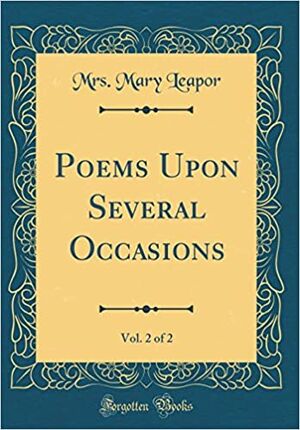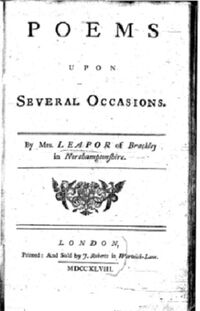
Mary Leapor (1722-1746), Poems upon Several Occasions Volume II (1751). Forgotten Books, 2018. Courtesy Amazon.com.
| Mary Leapor | |
|---|---|
| Born |
1722 Marston St Lawrence, Northamptonshire, England |
| Died |
1746 Brackley, Northamptonshire, England |
| Occupation | poet |
| Nationality |
|
|
Influences
| |
Mary Leapor (February 26, 1722 - November 12, 1746) was an English poet.[1] She is notable for being a critically well-received working-class writer of the period.
Life[]
Leapor was born in Marston St. Lawrence, Northamptonshire, the only child of Anne Sharman (died 1741) and Philip Leapor (1693–1771), a gardener.
Partly self-educated, she probably received a rudimentary education at either a local Dame school, or at the local free school in Brackley. According to her father she began writing "tolerably" at the age of 10. Her father recollected "She would often be scribbling, and sometimes in Rhyme", but that her mother ended up discouraging the writing, requesting she find some "more profitable employment".
She was fortunate enough to attain a position as kitchen maid with an employer, Susanna Jennens ("Parthenissa" in Leapor's poetry), who apparently encouraged her writing and allowed her the use of her library. Jennens wrote poetry herself and had connections to both Mary Astell and Mary Wortley Montagu. Not all employers were so accommodating and Leapor's devotion to writing led to her dismissal from a subsequent position with Sir Richard Chauncy’s family, as she apparently would not stop writing even in the kitchen. In 1784 an account was published in the Gentleman's Magazine, possibly by Chauncy’s son, allegedly describing Chauncy’s remembrances of the poet. According to this piece, Leapor’s
- fondness for writing verses there displayed itself by her sometimes taking up her pen while the jack was standing still, and the meat scorching... He represented her as having been extremely swarthy, and quite emaciated, with a long crane-neck, and a short body, much resembling, in shape, a bass-viol.[2]
She returned home to Brackley to care for her widowed father in 1744 or 1745, and despite many responsibilities and not the best of health she continued to write and her work circulated among the inhabitants of the town. As a consequence she met Bridget Freemantle (1698–1779), the daughter of a former rector, who became both her friend and mentor. This relationship seems to have marked a turning point for Leapor and she wrote the bulk of her oeuvre in a very short period.
It was Freemantle who suggested that Leapor publish a volume of poetry by subscription. A prospectus was drawn up, said to have been written by David Garrick. Freemantle also attempted to have a play of hers, a blank verse tragedy called The Unhappy Father, produced in London at the Covent Garden Theatre. (A 2nd play remains unfinished.) Neither venture was immediately successful.
Leapor died of measles at the age of 24.
Writing[]
Freemantle continued her quest to publish Leapor's work. In 1748 she arranged the posthumous publication of Poems upon Several Occasions, with approximately 600 subscribers, for the benefit of Philip Leapor. A 2nd volume of poetry and drama was published 3 years later by Samuel Richardson and edited by Isaac Hawkins Browne. Mary Delany, Stephen Duck, Elizabeth Montagu, and Sarah Scott were among the subscribers. These volumes secured Leapor's reputation as "one of the most interesting of the natural poets."[3] John Duncombe praised her in The Feminead (1754), and Bonnell Thornton and George Colman included her in their Poems by Eminent Ladies (1755).
Leapor herself would not seem to have embraced her status as a "natural" poet, "untainted" by artifice; she worked hard to acquire a literary education as best she could and embraced the neoclassical ideals of her period. At the time of her death she had accumulated 17 volumes and several volumes of plays: a considerable library for someone with such a limited income.[4]
There are many grammatical errors in Leapor's work, which Freemantle apologizes for in the Preface to the Poems Upon Several Occasions, assuring readers that, had Leapor lived to edit them, the poems would have been flawless. She continues that they are, nevertheless, entertaining.
Like many writers of the period, Leapor used a pastoral-sounding pen name; hers was "Mira." Much of her work is modeled on that of Alexander Pope, whose work she intensely admired. Jonathan Swift, particularly his anti-blason poetry (the de-emphasis on the female physical body in relation to nature), was also a model. At times Leapor's writing reflects her own pessimistic views on life as a woman who was described as being witty, poor, infirm, and unattractive. She writes "much of and to women, of the discrepancy of her sex and class with her poetic urge."[5] Her work clearly focuses on debunking romantic myths and reiterating the importance of education for women, the latter which she understood all too well.
From Leapor's "strongly feminist" "An Essay on Woman,"[6]:
WOMAN-a pleasing but a short-lived flower,
Too soft for business and too weak for power:
A wife in bondage, or neglected maid;
Despised if ugly; if she's fair-betrayed.
In "An Essay on Woman," Leapor describes the certain downfall women face when they get old. She is highly critical of women being judged solely on their appearance, and deplores the limited choices open to them. Like Alexander Pope, Leapor saw “the general condition of women as a series of contradictions”;[7] though unlike Pope or Jonathan Swift, they weren't “follies to be satirized,” but rather “injustices to be protested against”.[7] Both of the poets deeply influenced Leapor's work; however, she counters their interpretations and understanding of women's general unhappiness. Drawing from her personal experience as a woman, she saw injustice in the social order rather than in women themselves. This is reflected in the representation of her views on beauty, the female body, marriage, family and female friendship in her work.
Leapor lived in a culture where women were expected to value themselves by their beauty. A great deal of money would have been needed in order to achieve perfection in beauty, which required creating an artificial appearance: “hardware” was fastened about the bodies of women to straighten posture, stays squeezed their waists, and faces were “caked and heavily coloured” with cosmetics.[7] Leapor “attempts to see beyond artificial appearance to what she believes is more authentic femininity”.[7] Her poem "Dorinda at her Glass" exemplifies this as she describes a woman who has valued herself by the image she sees in the mirror, only to be devastated when she loses her youthful beauty with age:
To her lov'd Glass repair'd the weeping Maid,
And with a Sigh address'd the alter'd Shade.
Say, what art thou, that wear'st a gloomy Form,
With low'ring Forehead, like a norther Storm;
Cheeks pale and hollow, as the Face of Woe,
And Lips that with no gay Vermilion glow?
Through the poem Leapor advises and warns women that beauty does not last and to improve themselves intrinsically.
“In ‘Dorinda at her Glass’, ‘Advice to Sophronia’, and other poems, Leapor asserts that women should preserve their dignity by accepting the loss of beauty”.[7] Leapor herself is affected by standards of beauty, and wishes to escape her “plainness” and the vulgar comments on her appearance, and dreams of being beautiful. This wistfulness for mainstream acceptance and admiration is illustrated in her poems “The Visit” and “The Disappointment.”
Leapor’s most extensive examination of standards of beauty is “Corydon. Phillario. Or, Mira’s Picture.” In this “self-portrait,” Leapor attempts to break every contemporary standard of beauty. She picks apart her every bodily flaw openly, posing a challenge to a society which expected women to tuck away their defects:
Corydon.
But she has teeth --
Phillario.
--Consid'ring how they grow,
'Tis no great matter if she has or no:
They look decay'd with Posset, and with Plumbs,
And seem prepar'd to quit her swelling Gums.
Leapor also turned her attention to the marriage market:
(From Strephon to Celia) Now, madam, as the chat goes round,
I hear you have ten thousand pound:
But that as I a trifle hold,
Give me your person, dem your gold;
Yet for your own sake 'tis secured,
I hope – your houses too insured
Celia has admitted her love and admiration for Strephon and this is his businesslike reply. He goes on to practically count all of Celia's assets on his fingers. He assures her of his admiration, briefly and in highly conventional terms, then returns to the subject that really interest him: her fortune. Leapor ironically exposes the reality of the marriage market and how women are reduced to their financial worth, despite the veneer of sentiment.
Critical reputation[]
Today Leapor's work is celebrated for its sharp observations about life as a woman in the 18th century. She remains among the few female labouring-class writers of the period, along with Ann Yearsley and Elizabeth Bentley.
Recognition[]
Her poetry was anthologized in Poems by Eminent Ladies, 1755.
Publications[]

Mary Leapor (1722-1746), Poems upon Several Occasions, 1748. Courtesy Wikimedia Commons.
Poetry[]
- Poems upon Several Occasions. London: J. Roberts, 1748.
- Poems upon Several Occasions: The second volume. London: J. Roberts, 1751.
- An Essay on Woman: In three epistles. London: Gretton & Pottinger, 1763.[8]
Collected editions[]
- Works (edited by Richard Greene & Ann Messenger). London & New York: Oxford University Press, 2003.
Anthologized[]
- Poems by Eminent Ladies. London: Baldwin, 1755.
Except where noted, bibliographical information courtesy WorldCat.[9]
See also[]

"The Crucifixion and Resurrection. An Ode." by Mary Leapor
References[]
- Blain, Virginia, et al., eds. "Leapor, Mary." The Feminist Companion to Literature in English. New Haven and London: Yale UP, 1990. 640.
- Blunden, Edmund. A Northamptonshire Poetess: Mary Leapor. 1936.
- Gillespie, Stuart. “Leapor, Mary (1722–1746).” Oxford Dictionary of National Biography. Ed. H. C. G. Matthew and Brian Harrison. Oxford: OUP, 2004. 1 May 2007.
- Greene, Richard. Mary Leapor: A Study in Eighteenth-Century Women's Poetry. Oxford: Clarendon Press; New York: Oxford UP, 1993.
- Griffin, Dustin. "Mary Leapor and Charlotte Lennox." Literary Patronage in England, 1650–1800. Cambridge UP, 1996. ISBN 9780521560856; ISBN 0521560853
- Todd, Janet, ed. "Leapor, Mary (Molly)." British Women Writers: a critical reference guide. London: Routledge, 1989. 401-403.
- Van-Hagen, Stephen. "Mary Leapor." The Literary Encyclopedia. 3 Mar. 2007. Accessed 2 May 2007.
Notes[]
- ↑ Selected Poetry of Mary Leapor (1722-1746), Representative Poetry Online, University of Toronto, UToronto.ca, Web, Dec. 3, 2011.
- ↑ Stephen Van-Hagen, "Mary Leapor," The Literary Encyclopedia (3 Mar. 2007).
- ↑ Janet Todd, ed. "Leapor, Mary (Molly)." British Women Writers: a critical reference guide. London: Routledge, 1989. 402.
- ↑ Todd, 402.
- ↑ Virginia Blain, et al., eds, "Leapor, Mary," The Feminist Companion to Literature in English (New Haven and London: Yale UP, 1990. 640).
- ↑ Blain, et al., 640.
- ↑ 7.0 7.1 7.2 7.3 7.4 Richard Greene, Mary Leapor: A Study in Eighteenth-Century Women's Poetry (New York: Oxford University Press, 1993).
- ↑ An Essay on Woman in Three Epistles, Internet Archive, Apr. 6, 2012.
- ↑ Search results = au:Mary Leapor, WorldCat, OCLC Online Computer Library Center Inc. Web, July 31, 2016.
External links[]
- Poems
- "Mira's Will"
- Leapor, Mary (1722-1746) (2 poems) at Representative Poetry Online
- Leapor in A Book of Women's Verse: "Upon her Play being returned to Her Stained with Claret," "Hope," "of Friendship"
- Mary Leapor at PoemHunter (5 poems)
- Mary Leapor (1722-1746) info & 6 poems at English Poetry, 1579-1830
- Mary Leapor at Poetry Nook (21 poems)
- Mary Leapor at the Eighteenth-Century Poetry Archive
- Books
- Poems upon Several Occasions at Amazon.com
- About
| This page uses Creative Commons Licensed content from Wikipedia. (view article). (view authors). |
|